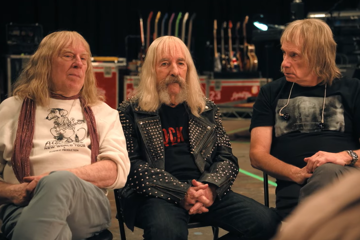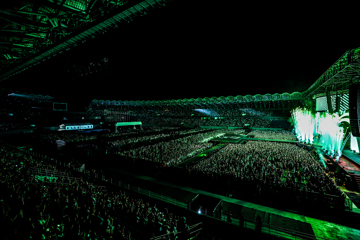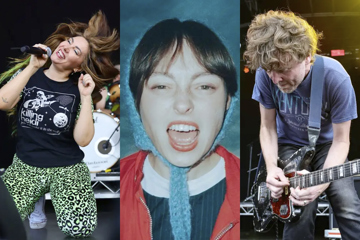In Theatre Show 'Can't Be Tamed', Miley Cyrus Becomes The Spirit Animal You Need In 2018
"One reviewer called it a "pill-popping pussy party."
Perfect pop starlet. Out of control wild child. Defiant symbol of sexual empowerment. Scandal-hungry anti-heroine. A bad influence. A role model. A girl. A woman. A try-hard. An icon.
Miley Cyrus has spent the majority of her 25-years as a shape-shifting commodity of mainstream pop culture, both fitting snuggly and breaking the moulds of the commercial music industry. But what is the true persona of this cultural chameleon? It's a question that theatre-makers Justin Nott and Danni Ray have pondered long and hard, although that's not say they've cracked the code of Cyrus's many contradictions. In their original theatre production, Can't Be Tamed, they channel Miley's mercurial spirit with the hopes of revealing something of the humanity hiding beneath her megastar status. The Music's Arts Editor Maxim Boon caught up with the pair ahead of the production's third revival, as part of the Midsumma Festival.
As muses go, the artist formerly known as Hannah Montana is not an obvious choice for a piece of contemporary theatre. So, what drew you and your fellow creators to Miley Cyrus?
Don't miss a beat with our FREE daily newsletter
Justin Nott: The burning desire to do a Miley show came about in Berlin, outside a public toilet (while my partner was struggling to work out a coin-operated door). Miley had just dropped her acid-dream-diary free album, Miley Cyrus And Her Dead Petz, the night before and I had listened to it in silence for the full ninety minutes staring out the window of our apartment, chain-smoking, mesmerised. In the morning, the press had torn it to shreds. I was frustrated that an established pop artist who had the gumption to throw away all preconceived notions of her sound and image and invest her own cash into an experimental and deeply personal album, collaborating with some truly eclectic artists, for free, was being criticised for self-indulgence. I thought, well, isn't all art self-indulgent to some degree? At least this was a pop artist stretching themselves, truly fucking around with their identity and laying their messed up psychology out in a glitter-clogged gutter. The general critical response felt misogynistic, cheap and elitist.
So I wanted to give people pause for thought about the experience of youthful introspection and traumatic self-reflection. As a queer man, that was an experience very close to home: who am I presenting to the world, what's actually going on in my head, and what's gonna happen when I finally blow the doors of my closet hinges. Not just in terms of sexuality, but in terms of who I am, who I was, who I will be. Miley embraces a kind of refusal to sit still in herself for too long. She's the embodiment of fluidity. That rang true to me. It felt necessarily queer in an age of capitalist-driven binaries. I wanted to let the audience into that experience and loosen them up a bit. She's got a bonkers mind and is a genuine empathy. We could use a bit more loving in the world.
While the subject matter is very squarely rooted in the experiences of Cyrus, this show isn't an impersonation. How did you approach finding the balance between channelling Miley and allowing your own voice as a performer to shine through?
Danni Ray: We never intended for the show to be a biographical recreation of Miley's life. Moreover, we wanted to use her persona as a lens through which to dissect issues faced by young women and those in the public eye. Justin and I agreed that accents onstage - unless flawlessly executed - can be really distracting. We preferred to create a story based around Miley, rather than speaking in her voice literally and figuratively.
As the publicity for the show proudly states: "This is not a cabaret or a fucking singalong." So, how would you describe it?
DR: It's a wild ride through the various versions of Miley that the world has seen, so far. It has all the flash and perk of a Disney show, and all the menace and control that comes along with it. It's like an acid trip on speed. Not that we'd recommend that...
JN: If my PhD supervisor asked me, I'd say it's about the internalised heteronormative pressure to perform a self that isn't true. And one reviewer called it a "pill-popping pussy party", so take your pick.
No doubt there's much for Cyrus fans to geek out over in the show, but what about those who aren't familiar with Miley's world? What else does this show communicate?
JN: At a really simple level, some people who have come out of the show not knowing a great deal about Miley have admitted to slut-shaming her in the past and suddenly feeling like that was wrong. That makes me happy.
Like Danni said earlier, our Miley is a lens, she's a magical unicorn you'll ride on for an hour in which her life becomes yours. It's a coming-of-age/coming-of-queer story, and that's for everyone. It's actually a deeply propagandist text indoctrinating your children with the queer agenda. If I'm honest.
There are a surprising number of Miley-metaphors percolating through this production, including ideas about the objectification of women in the entertainment industry, and how sexual empowerment and gender politics can be warped and manipulated by the media. How has using a foundation of pure pop culture allowed you to interrogate more hefty subtexts?
DR: Pop culture is definitely a major trendsetter in the world and something that seeps into our everyday lives more than we may realise. It influences and is influenced by the events of the world around us and can have huge effects on society - for better or worse. Using a pop culture icon to address broader issues felt like a no-brainer; everyone can relate to the feeling of being pressured by those around us to present in a certain way, and sometimes those external forces are what's holding us back from realising who we truly want to be.
JN: The thing I love about pop music is that its accessibility - by which I mean consumability - is kind of egalitarian. It's made for everyone. Maybe not always with depth, but who cares? So our Miley is like that - she's a pop song. She's an imagined hero. She's a bit of real Miley, a bit of Danni, a bit of me, a bit you, all thrown together and reflected back at us. With depth!
Can't Be Tamed was premiered at the 2016 Melbourne Fringe, and has since toured to Adelaide. Over the past year and half, how has the show evolved since the last time Melbourne audiences had a chance to see it?
DR: Justin and I spiralled deep into the Miley brain vortex in 2016, and barely had a chance to emerge and regroup before premiering the show for Melbourne Fringe. We both agreed that the concept was still raw in those early stages. Adelaide Fringe 2017 was a great chance to tighten the bolts and really hone in on the messages we wanted to deliver. The response from audiences was awesome. Now that it's been almost a full year since Adelaide, we've had enough space to come back to the show with fresh eyes and tweak things that never quite worked or emphasise things that did, which has been really exciting. I think this third version will be the most mature, concise and entertaining yet!
JN: Fringe is fringe is fringe. It's a testing ground. That's what's fun - and terrifying - about it. The most obvious way the show has changed is probably that it makes sense now! There's a lot more meat on the bones, we've really focused some of our ideas, dumped other ones, and refined the piece from top to bottom.
Oh! And spoiler alert for y'all, Billy Ray's in this one. Is that a selling point?
Midsumma Festival presents Can't Be Tamed from 24 Jan at La Mama Theatre







